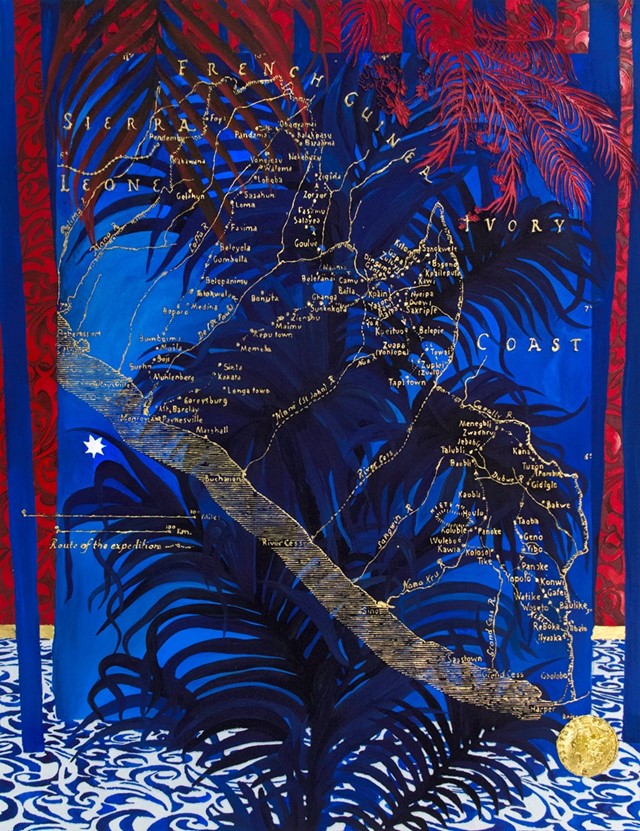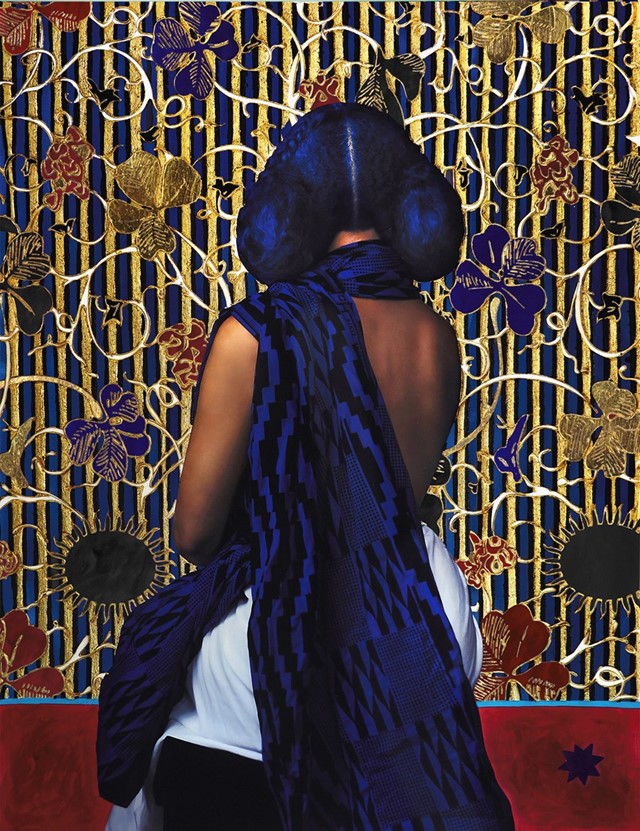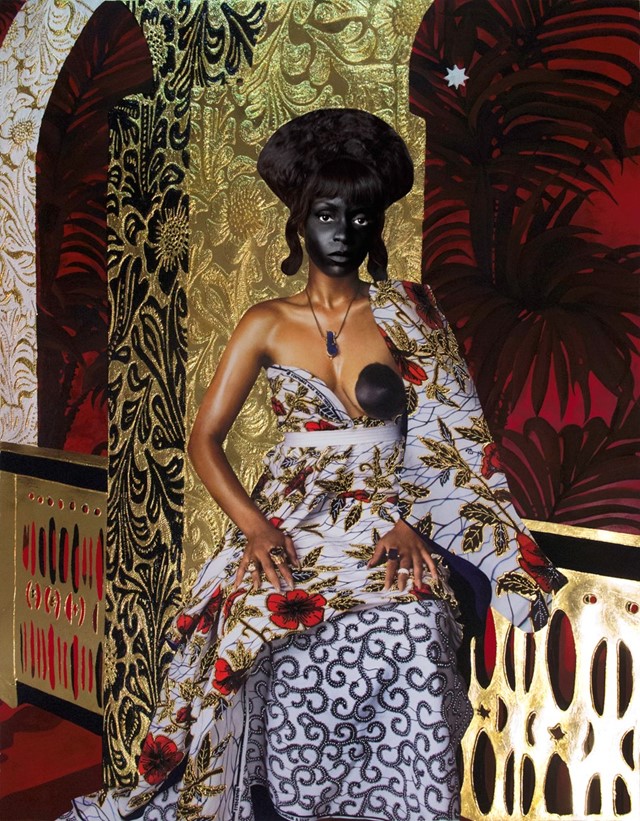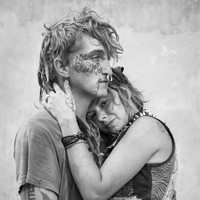Through a powerful use of black and gold, Viktor explores race, gender, and hidden elements of black history
After London-born, New York-based painter Lina Iris Viktor rejected two offers to make work for the music video of Kendrick Lamar’s Black Panther track, “All The Stars”, in February 2018, the clip was released featuring almost identical replicas of Viktor’s signature 24-carat gleaming gold geometric shapes. In the same month, Viktor filed a lawsuit against Top Dawg Entertainment by alleging copyright violation of her Constellations series. In the months that followed, Viktor’s name flooded the news as the artist suing Kendrick Lamar, where her artistic talent became overridden by legal jargon. As her current exhibition at the New Orleans Museum of Modern Art (NOMA) Lina Iris Viktor: A Haven. A Hell. A Dream Deferred, shows, Viktor is far more than her Kendrick Lamar lawsuit.
Through a carefully selected use of colour symbolism, as translated through black and gold, and a realism for painting black female bodies, every single one of Viktor’s paintings is layered with complex commentary on history, race, and gender. A Haven. A Hell explores the history of the African country Liberia, where her parents were born, and a nation founded by America after the emancipation of African-American slaves. Through a set of patterned paintings and references to mythology, Viktor not only traces her heritage but uses her paintings to bring light to the darkness of an unknown American history – in this sense, her work is a megaphone for the history of marginalised black identity in the US.
To celebrate the launch of her current show, below Viktor walks us through her practice and what makes her vision so unique.
THE SHOW IS ROOTED IN THE UNEASY RELATIONSHIP OF LIBERIA AND THE US
Lina Iris Viktor: The show is less about Liberia in terms of its contemporary standing and more about America's involvement in the creation of Liberia because it is a US colony. The country was founded as a place for free born and recently emancipated slaves to create their own country. Liberia was created for many reasons, the big reason was the fear of an uprising or revolution, because, at the time of the emancipation, there were large numbers of freed slaves on US soil who had all the reasons to be angry as they were. The other imperative was to get people off US soil. They pushed this idea of creating new autonomy and a new power structure for African Americans to govern themselves.

GOLD IS AN INTRINSIC PART OF HER WORK
Lina Iris Viktor: Gold is ennobling. I studied the ancient style of water gilding and I use 24-carat gold because of its emotional quotient and embedded narratives within the metal. People have a visceral reaction to real gold that you can’t replicate with painted gold. I think the greatest disservice to gold – and something that artist Yves Klein spoke about – is the way we have sullied the importance of it by making it a monetary bartering tool, and attributing it to simply financial value. Not to say that there isn't monetary value to gold, but the spiritual value of gold far outweighs that of the monetary value – and that’s what societies before us understood.
When you look at ancient Egypt or even Mali or Ghana, there was such a reverence for gold, where it didn’t have any monetary value. They used to bury their dead with gold and when you do this you understand the spiritual quotient of gold as this conduit between other worlds and us. Ancients likened it to the sun because it is the only metal that illuminates in the lowest light conditions – it reflects light and doesn’t consume it. It is at once the softest, and the most stable and immortal metal in the world.

PERFORMANCE IS A PART OF HER ARTISTIC HERITAGE
Lina Iris Viktor: I was in the performing arts as a child. I did a lot of plays and musicals, and that’s what I thought I was going to be doing with my life. The reason why I came to the US was to continue my theatre studies. Then I arrived here and got a culture shock. When I was in London, I was getting all kinds of roles. You can play men or women, or black or white. It didn't really matter, all you needed was to be able to play the role. But in America, I was very much stereotyped by my blackness. That was my experience in college, so I could only imagine what the politics would be on professional stages. I decided that wasn't going to be my battle to fight. I had no interest in trying to prove my skill set against my race – that was confining – so I decided to switch gears into film.
SHE WORKED FOR SPIKE LEE
Lina Iris Viktor: I’ve always searched for autonomy. I started to study film and graduated with a major in art, focusing on film studies. From film history to film documentary, DoP’ing, and screenwriting, I also started working for Spike Lee. It was for just under a year and helped me realise that I didn’t want to work in film, again, because of the politics. Making art professionally is very different from just making art. There’s always a space that you have to navigate and deal with the politics of the industry. It was so male-oriented and there was so much machismo. On top of that, it requires a lot of people to be able to do it, and that can compromise the vision. That’s when I started to put film aside. All of these things I've done feed into each different aspect of my practice. In 2013, I started doing photography and making artworks.
I always tell young people who want to become artists, don’t go to art school because if you’re an artist, you’re an artist – just do it. You should learn how to do something else that will support you to make art professionally, rather than learning how to become an artist. How many people go to art school who never make any work? Talent is not based on education.
“If you’re an artist, you’re an artist – just do it” – Lina Iris Viktor
SHE USES BLACK AS A COLOUR OF NOBILITY
Lina Iris Viktor: In art school most people are always told to stay away from black because there’s an idea that it absorbs all other colours, it has this overpowering effect. Yes, there are artists that principally use black or have palettes that lean towards black, but it’s few and far between, which I think is because of what we are taught.
Black to me is one of the noblest colours. Artist Louise Nevelson once said it was the most aristocratic of colours because it is akin to the universe. You look up at the sky and what do you see? You see blackness, you see darkness. What she shows about the universe or when people talk about the big bang was that there was nothing and then we came to be, but then nothingness is just blackness. And we don’t know how to describe dark matter, but to the human eye, it looks black. So to me, black is the prima materia. It’s the primary material from which all things are birthed, so that’s why, and how, I use black the way I do.
MALIAN PHOTOGRAPHER, SEYDOU KEÏTA, IS A KEY INFLUENCE
Lina Iris Viktor: Something I always come back to, and someone who is often referenced, is Malian photographer Seydou Keïta. Everyone talks about Malick Sidibé, who I love too, but Seydou Keïta is like the father. I was introduced to his work properly when I was in college and fell in love with the ennobling or the way that it was so counter to what was being shown to me – even then when I knew less about my own culture. You grow up in the west with a very negative view of Africa, because that’s what always becomes the conversation. It’s always about corruption, sickness, and poverty, and all of these things which are not true. There is that everywhere in the world, but that’s the narrative that gets played up the most. When I would see images of these beautiful women and men in their full versions of their regalia looking so ennobled, I was like ‘oh, this is something I haven’t seen before. This is a representation of us that I have never seen before’. So, that’s why I always return to his work.
Lina Iris Viktor: A Haven. A Hell. A Dream Deferred is on at the New Orleans Museum of Modern Art until January 6 2019. You can find out more here










